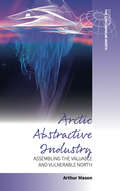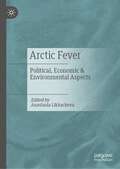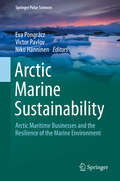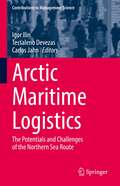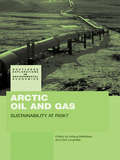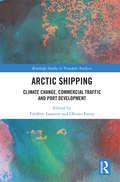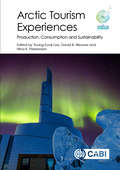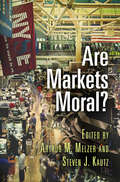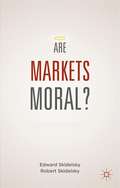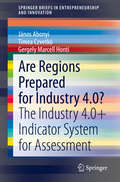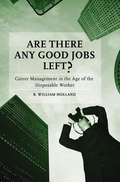- Table View
- List View
Arcor: Global Strategy and Local Turbulence
by Pankaj Ghemawat Michael G. Rukstad Jennifer L. IllesArgentine confectionery manufacturer, Arcor Group, seeks to implement an international strategy but in 2003, recovering from the Argentine financial crisis, thwarts globalization plans. Already Latin America's leading candy producer and an exporter to over 100 countries, Arcor analyzes how it can become truly global with production facilities and distribution networks in various regions, such as North America, Europe, and Asia. First, however, Arcor must stabilize its operations at home, where a devalued peso, economic uncertainty, and political instability still linger from the devastating financial crisis.
Arcor: Global Strategy and Local Turbulence (Abridged)
by Pankaj Ghemawat Michael G. Rukstad Jennifer L. IllesArgentine confectionery manufacturer, Arcor Group, seeks to implement an international strategy but in 2003, while recovering from the Argentine financial crisis, globalization plans are thwarted. Already Latin America's leading candy producer and an exporter to over 100 countries, Arcor analyzes how it can become truly global with production facilities and distribution networks in various regions, such as North America, Europe, and Asia. First, however, Arcor must stabilize its operations at home, where a devalued peso, economic uncertainty, and political instability still linger from the devastating financial crisis.
Arcos Dorados: A QSR Recovery Plan
by Jose B. Alvarez Forest L. Reinhardt Mariana Cal Jenyfeer Martinez BuitragoArcos Dorados-McDonald's largest independent franchisee, covering Latin America and the Caribbean (LAC)-faced a pandemic that was disrupting the entire consumer foodservice business in 2020. With the exclusive right to own, operate, and sub-franchise McDonald's restaurants in LAC since 2007, the company served over 40 million customers a day at its almost 2,300 restaurants sprawled in 20 markets across LAC, reporting revenues of roughly $3 billion and $291.8 million EBITDA in 2019. Although results for 2020 had looked promising, in late March 2020, governments throughout the region implemented quarantine measures in response to a novel coronavirus disease (COVID-19), affecting the company's normal operations. Forced to withdraw a previously approved 2020-2025 plan for restaurant openings and reinvestments, the company had to focus on a strategy to reduce the impact of the pandemic on the company's finances. Based on its strengths vis- -vis its competitors, Arcos Dorados' recovery plan hinged on five pillars: i) McDonald's restaurants' reputation for people care and food safety; ii) the company's capabilities to explore new channels for food purchasing and delivery; iii) McDonald's good "value-for-money" perception; iv) a consolidated brand with unique offerings; and v) a sustainable-minded company, with initiatives underway to enhance its brand image. Once the crisis was contained, the company had to draft a new six-year plan, including capital outlays for restaurant openings and reinvestments. Given its current position and strengths against its competitors, should Arcos Dorados grasp this opportunity to pursue an aggressive growth plan? Or, considering the post-pandemic economic downturn expected in the region, should the company come up with a more conservative plan or even contemplate downsizing? How should the plan differ by country?
Arcos Dorados: How to Lead and From Where
by Krishna G. Palepu Gustavo A. HerreroAcros Dorados, an Argentina-based multinational, is facing new organizational challenges as it seeks to build on its recent turnaround, and grow in Brazil and Mexico. Woods Staton and his management team have to make some hard decisions on how to structure and lead the company going forward.
Arctic Abstractive Industry: Assembling the Valuable and Vulnerable North (Studies in the Circumpolar North #5)
by Arthur MasonThrough diverse engagements with natural resource extraction and ecological vulnerability in the contemporary Arctic, contributors to this volume apprehend Arctic resource regimes through the concept of abstraction. Abstraction refers to the creation of new material substances and cultural values by detaching parts from existing substances and values. The abstractive process differs from the activity of extractive industries by its focus on the conceptual resources that conceal processes of exploitation associated with extraction. The study of abstraction can thus help us attune to the formal operations that make appropriations of value possible while disclosing the politics of extraction and of its representation.
Arctic Abstractive Industry: Assembling the Valuable and Vulnerable North (Studies in the Circumpolar North #5)
by Arthur MasonThrough diverse engagements with natural resource extraction and ecological vulnerability in the contemporary Arctic, contributors to this volume apprehend Arctic resource regimes through the concept of abstraction. Abstraction refers to the creation of new material substances and cultural values by detaching parts from existing substances and values. The abstractive process differs from the activity of extractive industries by its focus on the conceptual resources that conceal processes of exploitation associated with extraction. The study of abstraction can thus help us attune to the formal operations that make appropriations of value possible while disclosing the politics of extraction and of its representation.
Arctic Fever: Political, Economic & Environmental Aspects
by Anastasia LikhachevaThis book explores the Arctic as a rapidly evolving phenomenon in international affairs of a rising number of stakeholders. For decades, Arctic studies used to be an affair of a relatively narrow group of experts from northern countries. This time is over due to a new Chinese Arctic policy, as well as growing regional interests from South Korea, Singapore, India and Japan. Contributors reflect on new roles for the Arctic region: both as a playground for the old school nation state competition and even confrontation, and a new source for international cooperation in energy, logistics and natural sciences. Climate change, political tensions and economic competition make Arctic a hotter venue of international relations. This new Arctic fever, studied through a comparative analysis of different regional agendas, especially with a focus on the US–China–Russia triangle, represents the main subject of our book, which will be of interest to scholars of geopolitics, of climate change, and of 21st century energy economics.
Arctic Marine Sustainability: Arctic Maritime Businesses and the Resilience of the Marine Environment (Springer Polar Sciences)
by Eva Pongrácz Victor Pavlov Niko HänninenThis book presents the latest scientific views on resource use conflicts in the Arctic seas. The main areas of focus are the biological resources of Arctic seas vs. exploitation of oil and gas resources, and the conflicts in between. In addition, climate change is presented as a stressor, which both limits and facilitates the economic availability of resources in the Arctic. The book is divided into five parts. Part 1 examines Arctic ecosystems, resilience of the marine environment and possible conflicts between industrial sector and biological world. The focus of Part 2 is on transport infrastructure along the northern routes. Issues such as Arctic maritime operations, black carbon and unmanned aerial vehicles are considered. Part 3 focuses on resource use conflicts in Arctic seas and on the most recent threats in terms of Arctic oil and gas exploration, offshore logistics operations as well as transportation of oil and oil products. Discussions in Part 4 of the book are concentrated around social aspects and involvement of local communities. Tourism development, preservation of indigenous culture, engagement of communities on relevant Arctic issues, search and rescue in the cold marine environment are examples of questions raised. The book reviews Arctic-specific petroleum regulations, the state of preparedness to oil spill accidents in the region as well as the latest developments in oil spill response technologies and their limitations. Search and rescue operations are reviewed and how working in this harsh Arctic environment affects the ability of rescue technicians to perform the required technical skills. Part 5 considers the sustainability challenges arising from the marine resource exploitation. The focus is on the vulnerability of Arctic ecosystems to disturbance – both natural and anthropogenic.
Arctic Maritime Logistics: The Potentials and Challenges of the Northern Sea Route (Contributions to Management Science)
by Tessaleno Devezas Igor Ilin Carlos JahnThe modern shipping industry has reached maturity; market demand and landscape shifts force industry agents to find new pathways to successful development. The Northern Sea Route (NSR) as a new pathway between Europe and Asia brings both opportunities and challenges to global logistics systems. These circumstances make commercial exploitation of the route a subject of intense focus in many countries actively involved in sea transportation. This book identifies specific problems and provides possible solutions to them by calling on the accumulated knowledge of researchers and practitioners with competencies from diverse areas, including transport and logistics, Arctic studies, IT and digital technologies, socio-economic systems analysis, hydrocarbon production, transport, business modeling, design of information systems and applications, and engineering requirements for IT services. It represents the integrated experience and expertise of researchers from Canada, Germany, Russia, and the Netherlands, including experts from oil and gas enterprises, shipping lines, logistics companies, and IT companies.
Arctic Oil and Gas: Sustainability at Risk? (Routledge Explorations In Environmental Economics Ser.)
by Oluf Langhelle Aslaug MikkelsenThis book analyzes the expanding oil and gas activities in the Arctic from the perspective of Sustainable Development (SD) and Corporate Social Responsibility (CSR). The focus is on the territories of the Arctic rim where the current and future oil and gas activities in the Arctic are and will be located. The book raises a number of questions inclu
Arctic Shipping: Climate Change, Commercial Traffic and Port Development (Routledge Studies in Transport Analysis)
by Édéric Lasserre Olivier FauryThis book considers both the present state of Arctic shipping and possible future trends with reference to the various sectors of maritime transportation: cruise tourism, container traffic and bulk shipping. Ports are analysed as tools that support the strategies of coastal states to foster the development of resource extraction, enhance the attractiveness of Arctic shipping lanes and enable the control of maritime activities through coast guard deployment. The aim of this book is to draw a picture of the trends of Arctic shipping. How is traffic evolving in Canada’s Arctic, or along the Northern Sea Route? Are there significant differences between bulk and container shipping segments when considering the Arctic market? How are the ports and the hinterland developing and what are the strategies behind those? How is the legal framework shaping the evolution of maritime transportation? The contributors to this book consider all of these questions, and more, as they map out the prospects for Arctic shipping and analyse in detail the development of Arctic shipping as a result of multi-variable interactions. This book will be key reading for industry professionals and post-graduate students alike.
Arctic Timber AB: Engineered Woods Division (A)
by Wendy Smith Michael L. Tushman David KironDescribes the leadership challenges involved in managing strategic innovation and change in a highly mature business unit. Allows systematic exploration of organizational structures, incentives, competencies, and culture that impede innovation. Pivots on a new leader's dilemmas in shaping both his team and larger organization to initiate both incremental as well as radical innovation.
Arctic Timber AB: Engineered Woods Division (B)
by Wendy Smith Michael L. Tushman David KironSupplements the (A) case.
Arctic Timber AB: Engineered Woods Division (C)
by Wendy Smith Michael L. Tushman David KironSupplements the (A) case.
Arctic Tourism Experiences: Production, Consumption and Sustainability
by Carl Cater Line Mathisen Peter Fischer Isabelle Guissard Arild Røkenes Sara Davoudi Claes Högström Bård Tronvoll Johan Edelheim Kjell Olsen Laura J Lawton Stein R Mathisen Hans Anton Stubberud Carsten Blom Ruud Ming-Feng Huang Chuanzhong Tang Raija Komppula Beate Bursta Giovanna Bertella Sølvi Lyngnes Margaret E. Johnston Elsa De Souza R. Harvey Lemelin Sergey Ilkevich Per Strömberg Peter Haugseth Urban WråkbergAn exploration of Arctic tourism, focusing on tourist experiences and industry provision of those experiences; this is the first compilation to concentrate on the fundamental essence of the Arctic as being a geographical periphery, but also an experiential core that offers peak tourism experiences. Part 1 investigates the depth and dimensions of tourist experiences in the Arctic. Chapters examine the essence of diverse peak experiences and delve into the factors that give rise to these experiences. Part 2 considers the links between these core experiences and the tourism industry that seeks to sustain itself by facilitating such satisfying outcomes.
Ardian - The Sale of Diana
by Michael Roberts Paul A. GompersThe case focuses on a European private equity form - Ardian - and the process it uses to sell one of its portfolio companies, and the decisions around that sale. Key issues include the choice of an auction or acceptance of a pre-emptive bid, and the role of the portfolio company's management in the process. The case explores the kinds of influence company management can, and should, have in the sale process. The case also explores issues at the PE firm level, including the fact that the firm has recently been spun off out of its large parent financial services firm, and how the GP entity was valued during that spin-out.
Ardian: Portfolio Company Governance
by Lynn Sharp Paine Emer Moloney Tonia LabruyereLeaders of the mid cap buyout group at Ardian, the Paris-based private equity firm led by Dominique Senequier, have been asked to review and assess the governance model the firm uses for majority-owned companies in its portfolio. The case describes the governance model and then shows how it has worked in practice at two companies: Italy's orthopedic implant maker Lima Corporate and French chemical company Novacap. For each company, the case describes how Ardian decided on the investment and established a board of directors, and details the deliberations around some of the critical decisions made by each board during Ardian's tenure as majority shareholder. Through the two examples of Lima and Novacap, the case invites students to evaluate Ardian's approach to corporate governance in its portfolio companies and to recommend possible changes or improvements.
Ardian: Portfolio Company Governance (A)
by Lynn Sharp Paine Emer Moloney Tonia LabruyereLeaders of the mid cap buyout group at Ardian, the Paris-based private equity firm led by Dominique Senequier, have been asked to review and assess the governance model the firm uses for majority-owned companies in its portfolio. The case describes the governance model and then shows how it has worked in practice at two companies: Italy's orthopedic implant maker Lima Corporate and French chemical company Novacap. For each company, the case describes how Ardian decided on the investment and established a board of directors, and details the deliberations around some of the critical decisions made by each board during Ardian's tenure as majority shareholder. Through the two examples of Lima and Novacap, the case invites students to evaluate Ardian's approach to corporate governance in its portfolio companies and to recommend possible changes or improvements.
Are Capital Controls Effective in the 21st Century? The Recent Experience of Colombia
by Benedict Clements Herman KamilA report from the International Monetary Fund.
Are Emerging Asia's Reserves Really Too High?
by Marta Ruiz-Arranz Milan ZavadjilA report from the International Monetary Fund.
Are Great Leaders in Control of Their Companies?: An Evidence-Based Approach to Leadership
by Robert I. Sutton Jeffrey PfefferThis chapter explores the half-truth that leaders are in control and that they ought to be, provides a more nuanced view of leadership, and offers some useful guidelines for those who occupy leadership roles in organizations.
Are Markets Moral?
by Arthur M. Melzer Steven J. KautzDespite the remarkable achievements of free markets—their rapid spread around the world and success at generating economic growth—they tend to elicit anxiety. Creative destruction and destabilizing change provoke feelings of powerlessness in the face of circumstances that portend inevitable catastrophe. Thus, from the beginning, capitalism has been particularly stimulative for the growth of critics and doomsayers. While early analysts such as Karl Marx primarily emphasized an impending economic disaster, in recent years the economic critique of capitalism has receded in favor of moral and environmental concerns.At the heart of this collection of original essays lies the question: does morality demand that we adopt a primarily supportive or critical stance toward capitalism? Some contributors suggest that the foundational principles of the capitalist system may be at odds with the central requirements of morality, while others wonder whether the practical workings of markets slowly erode moral character or hinder the just distribution of goods. Still others consider whether morality itself does not demand the economic freedom constitutive of the capitalist system. The essays in Are Markets Moral? represent a broad array of disciplines, from economics to philosophy to law, and place particular emphasis on the experiences of non-Western countries where the latest chapters in capitalism's history are now being written.Contributors: Andrew S. Bibby, Gurcharan Das, Richard A. Epstein, Fonna Forman, Robert P. George, Steven J. Kautz, Peter Augustine Lawler, Steven Lukes, Deirdre Nansen McCloskey, Peter McNamara, Arthur M. Melzer, John Tomasi.
Are Markets Moral?
by Edward Skidelsky Robert SkidelskyThis volume scrutinizes the functionality of a capitalist market society, which is usually praised for the efficiency and dynamism, rather than for its morality. It addresses the dualism behind capitalism's encouragement of greed, which is usually considered to be a moral failing, while also being a driver behind economic growth.
Are Regions Prepared for Industry 4.0?: The Industry 4.0+ Indicator System for Assessment (SpringerBriefs in Entrepreneurship and Innovation)
by János Abonyi Tímea Czvetkó Gergely Marcell HontiThe concept of industry 4.0 is spreading worldwide and readiness models exist to determine organizational or national maturity. On the other hand, the regional perspective of the digital transformation is yet to be widely researched, although it significantly determines how the concept of industry 4.0 can be introduced to the organisations. This book identifies the regional aspect of industry 4.0 and provides a regional (NUTS 2 classified) industry 4.0 indicator system model that is based on open data sources. This new model serves as a tool to evaluate regional economy to support governmental decisions. It also provides territorial councils with a decision-support tool for field investment decisions. And finally, this model offers investors with a heat map to evaluate regional economies successful implementation of industry 4.0 solutions.
Are There Any Good Jobs Left? Career Management in the Age of the Disposable Worker
by R. William HollandThis book is for and about the millions of people who are between jobs (code for "out of work"), have been between jobs, or know of someone who has been. It is about how to navigate the transition from employment-for-life, career development support, and a company-sponsored pension to downsized, outsourced, and replaced. Bill Holland explains the macro-trends that have converged to create an environment of job instability and anxiety, and then moves beyond this context to present specific tactics and techniques that readers can use to stay one step ahead in their careers. More than a manual for job searches and career-building strategies, Are There Any Good Jobs Left? helps readers interpret trends, assess such temptations as leaving the corporate rat race for the entrepreneurial life and considers the ethics of constant networking. Featuring an annotated listing of books and Web sites, the book is not so much an indictment of corporate disloyalty as an explanation of the phenomenon, and a guidebook for anyone faced with job transition, change, or growth in today's turbulent environment.

